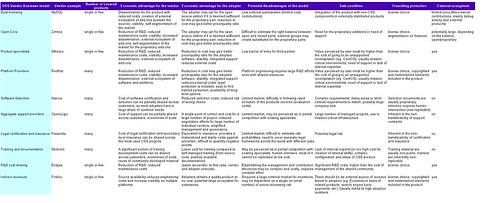As a follow-up to our previous research in FLOSSMETRICS and OpenTTT, we are trying to improve our original classification, adapting it to the many changes that are happening in the commercial open source world. As a preliminary result, I would like to share with you the preliminary second version of our OSS model taxonomy, that includes a few relevant changes:
- It does, for the first time, disaggregate what was originally called ITSC (Installation, training, support, consulting) because many successful companies are now specializing in a single activity. This is a significant change from 2006 (when we started collecting data on OSS models), when companies were performing in a more or less undifferentiated way all those activities. We believe that this “specialization” will continue with the enlargement of the commercial OSS market.
- We removed the “badgeware” category from the list. We found that some of the vendors that originally followed this model disappeared, and for those remaining protection from freeriding and overall model was more or less morphed into a “open core” or “split oss/commercial”. As the visibility clause can now be included in the GPLv3, I believe that the remaining few badgeware licenses will disappear quickly.
- We have added an experimental section, related to the advantages for the vendor and for the adopters of OSS models. This section is in my opinion quite important in making this a sort of “cheatsheet” for companies that will be interested in using an OSS business model in the future, but is still subject to some revision. I would be grateful for any suggestion or correction to it.
Anyway, here is a link to the table in ODS format, and in html format:

#1 by Matthew Aslett - March 6th, 2009 at 11:19
Shame its not very printer friendly (I’m old school like that) but great stuff and potentially very useful. I’ll take a proper look before I offer any feedback
#2 by cdaffara - March 6th, 2009 at 11:32
You are of course right. I have added a download for the ODS file, so it may be easier to print it out. And the license is CC-Attribution-Sharealike.
#3 by Matthew Aslett - March 6th, 2009 at 11:36
Fantastic
#4 by Andrew Ross - March 14th, 2009 at 17:40
This is excellent. Thank you.
It might be interesting to keep track of companies vs. business model and graph their results over time. This might provide an insight as to the relative effectiveness of each model. Does anyone know if this has been done already?
#5 by cdaffara - March 14th, 2009 at 18:39
Unfortunately I know of no such effort, despite its potential high usefulness. We started collecting data on business models around 2004, but it was done in an unorganized and unstructured way; the Flossmetrics project was the opportunity to perform an initial, large scale analysis.
#6 by Rinse Repeat - March 19th, 2009 at 05:39
Oh my. Are people still wasting their time writing these articles. I think this topic was covered completely about 5 years ago.
#7 by cdaffara - March 19th, 2009 at 08:20
For Rinse Repeat: it may be a surprise, but despite many efforts there is still much more to say (and I started writing on this in the European Working Group on Libre Software, in 1999). After all, we are still writing on the death of newspaper and the internet right now (like Clay Shirky’s new post on this) and after all the topic was believed to be completely covered 10 years ago…
The fact is that OSS changes, models change, and the ecosystem change- there are many more companies working with OSS now, how to monetize things changed, and still there is debate on whether there is a “best” model or what this model would be. After all, with OSS at 25% of the software market right now, having no new research done in 5 years would be quite strange for me.
#8 by Berkay Sözbilir - August 30th, 2009 at 18:38
wow, absolutely post.
thanks cdaffara.